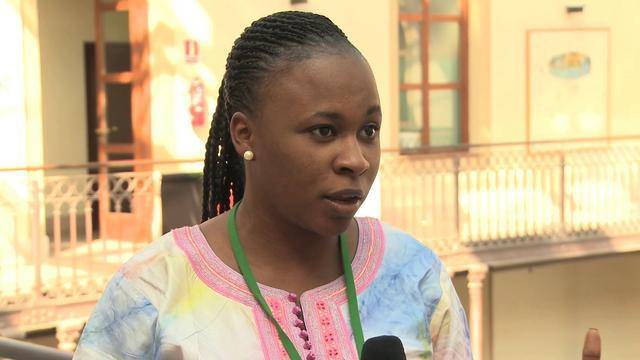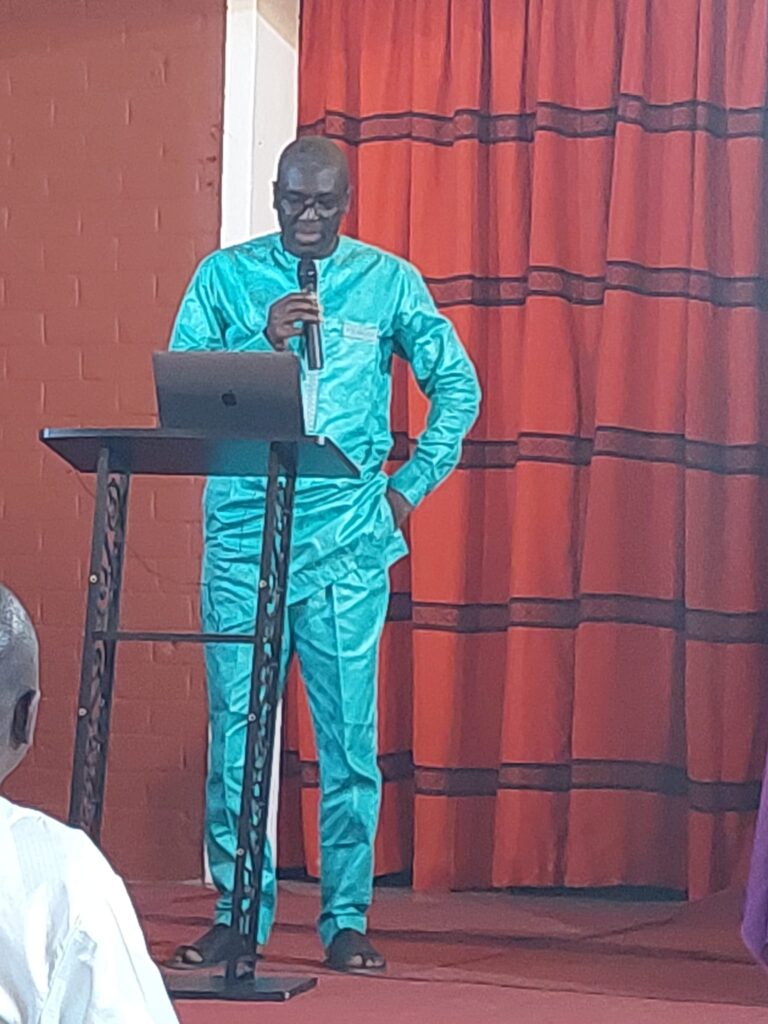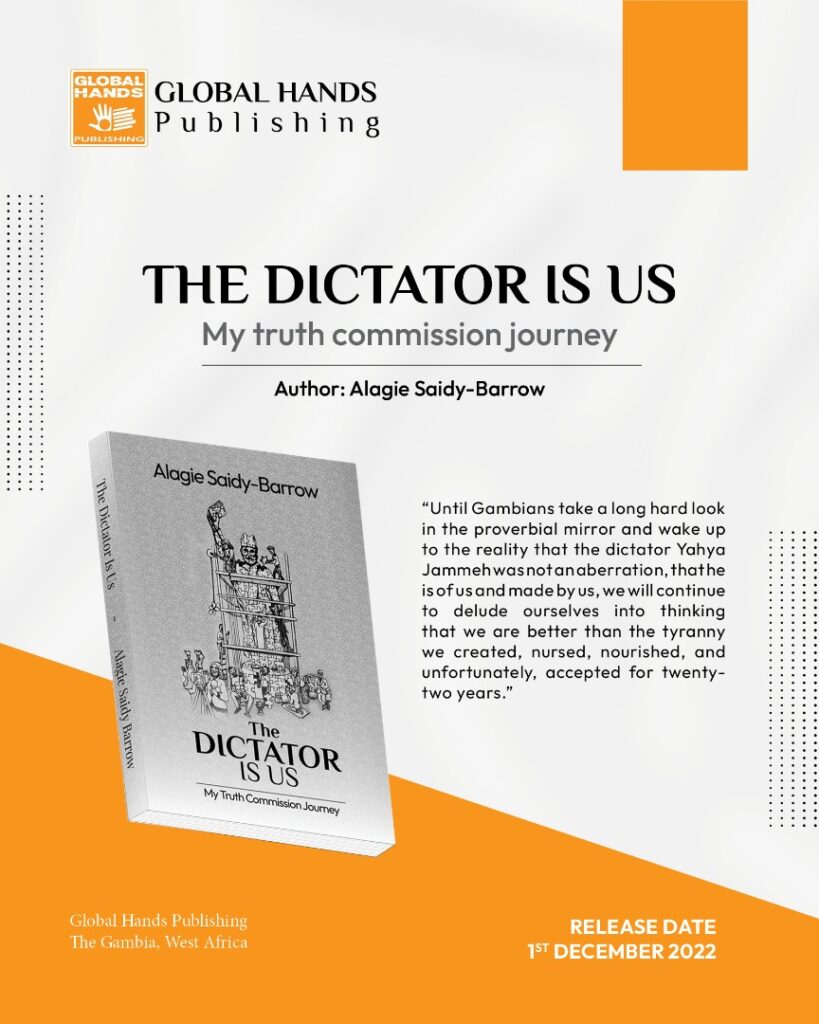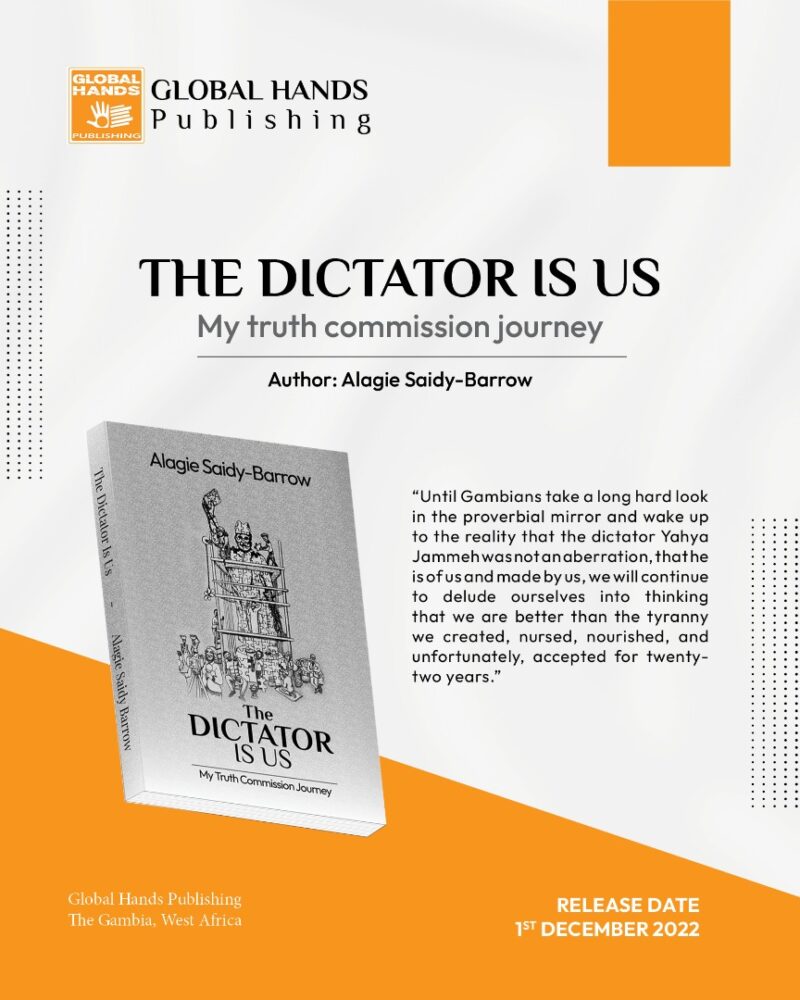BOOK REVIEW BY NDEY TAPHA SOSSEH
THE DICTATOR IS US by ALAGIE SAIDY BARROW
EBUNJAN THEATHER DECEMBER 16 2022.

Alagie Barrow’s The Dictator is Us is a startlingly fresh, undyed chronicle of life under a dictatorship culminating in his short stint as head of Investigations at the Truth Reconciliation and Reparations Commission (TRRC).
Launched almost a year to the day the TRRC Report was handed over to the Government of The Gambia, the 320 pages captured in a 26-chapter book is a stark reminder of the enormous suffering of a people under twenty years of dictatorship and the significant sacrifices – personal, financial, physical, psychological and emotional made by some Gambians including the author himself to free its people from this bondage.
It is a testimony of our common memory and common experience as Gambians and it is more than necessary for us as a society, to protect this memory. One way of preserving this memory is to be able to erect a solid bridge between our values and realities and to present them without drama.
The Dictator is Us is a refreshing recounting of exchanges that are to be encouraged so that history serves to boost the momentum of the present. The book tries to unlock the slimy, dark, and oftentimes silent terror that we, the Gambian people had to endure under the dictatorship and should serve as a clarion call, for each and every one of us to commit to the Never Again slogan of the TRRC.
It is a reminder for us to also commit in many ways through our various platforms to ensure that Justice is done in the name of each and every victim of the Yahya Jammeh dictatorship.

In a nutshell, The Dictator is Us, challenges us to reflect on who we are as a people for even though Yahya Jammeh was the principal dictator, the dictatorship thrived as many enablers and mini-dictators helped along the way. This status quo is succinctly captured by Alagie Barrow in page 10 where he states that through his interactions with various witnesses, he « would come to learn how the APRC dictatorship was birthed, nursed, raised, and sustained by fellow Gambians. While Yahya Jammeh was the lynchpin of the 22-year dictatorship, he had many enablers who legislated, promoted, aided, and supported his maladministration and abuse of Gambians ».
Though Alagie coherently weaves a symbiosis showing a Gambia tempered with care, courage, empathy, love, selflessness in seeking to protect safeguard the physical and psychological well-being of friends, neighbors, and complete strangers, this book is also a sad indictment of our Gambian characteristics of betrayal, cowardice, deception, dishonor, greed, hate, lies, wrongdoing, and other negative behaviours which led to dispossession, disappearances, killings, robbery, shame, suffering of a people (mostly in silence).
The distinctness and linguistic command used to describe people, events, and thoughts enrich brilliant storytelling with clarity. His experiences with leaving The Gambia for the first time, including a hurried departure and eventual settling in the US with his family and the feelings of not knowing what to do, going in any and all directions in seeking to assist and help Gambians, victims of the dictator at home and those who managed to flee resonate well with me as we had similar experiences.
In Page 11, Alagie questions our underlying ideas of “justice and our notion of crime and punishment” and hopes that The Dictator is Us will “spur people to take stock of our individual and collective actions, and to reflect on the nation we are creating for ourselves and for generations yet unborn”.
At my level his hope has been realized for after having testified at the TRRC and being the daughter of the Commission’s Vice Chair, I had taken a personal decision to desist from commenting on anything and everything TRRC as Gambians have the ability of misquoting and misconstruing things people say or do and I did not want the brilliant work of the Commission to be marred by any misrepresentations by persons who were so inclined. A position that is also in line with an earlier decision that I made following a short stint as Advisor at MOICI.

It was not a light decision for me to detach myself from Gambian matters as I spent my entire youthful days in a sustained fight against dictatorship and in a quest to bring meaningful change. This Change eventually happened in December 2016 when Gambians finally had enough of the human rights abuses, bullying, butchery, and bad boy behaviour and courageously did the needful by voting Yahya Jammeh out of office in December 2016.
Having achieved the common objective of ousting The Dictator, it would have been nice and consistent to work with like-minded persons to bring about the effective change we wanted for The Gambia. Yet, the residual of the bad boy/girl behaviours indicted that it was best to take a back seat and instead concentrate on restoring my equilibrium having expended so much of my time, energy, emotional intelligence, and finances in fighting a dictatorship.
This decision had to be reversed when Alagie Barrow called about a month ago asking that I review his book, some sort of memoir on the TRRC. My initial reaction was to decline in line with my decision to take a back seat with matters pertaining to The Gambia, particularly in respect of the TRRC and MOICI. I could not and would not give detractors the opportunity to muddy the waters. However, the request was from a man I had the utmost respect for so I asked that he send me an e-copy of the book. Just seeing the title, I was convinced that it would be foolhardy to say no. This, is despite our agreement that I would assist in identifying a reviewer, bearing in mind Alagie’s preference for a victim.
Before reading the book I was apprehensive about what Alagie Barrow could possibly say about the TRRC given how high profiled and public the TRRC and its processes were. I couldn’t be more wrong. Touching on all stages of the Commission in particular the coming into being of the TRRC, The Dictator is US is a timeless testament to how far institution building/maintenance is a major developmental issue in The Gambia and further testifies that beyond the visible teamwork, camaraderie and solidarity, institutions which make an impact in The Gambia are mostly carried along by the steely determination of a few visionary individuals. And, The TRRC was no exception.
Describing on page 12 the “dingy office” in the Ministry of Justice -the shared space from which he and the Executive Director had to operate from at the beginning and contrasting the tired and old MoJ buildings with the ultramodern building National Intelligence Agency (NIA) office which is right next door with beautiful and shiny furniture to boot, showed him where Gambia Government priorities lie. “The NIA helps protect the power of the president and ensures he remains safe. Justice, as with everything else in The Gambia, is secondary to power”.
These differences are not only seen in the infrastructure but were also discerned in the behaviour of some the leadership of the state security institutions towards the TRRC. Contrary to the push backs by the NIA/SIS leadership to requests by Alagie Barrow for a meeting to develop an MoU, the late IGP Mamour Jobe opened his doors for them and supported the security operations of the TRRC premises, and assured them “of his support and asked us to let him know if we needed anything team”. Similarly, Director of Prisons, Ansumana Manneh was very helpful and offered the TRRC his fill cooperation. “It was apparent that Ansumana Manneh, like Mamour Jobe, had a very clear conscience with nothing to hide.” The same could not be said of the NIA/SIS and army leadership.
This statement takes me back to page 13 Chapter 3 when Alagie tells a friend that at least the NIA has a mosque for the Muslims on the staff to which the friend “remarked that the NIA staff probably need to pray a lot more given what they have done to Gambians”. The great damage that they did is discussed in Chapter 18 which covers in detail the role and powers of the NIA and how they maintained a culture of impunity by violating citizens in the name of national security. Through the NIA/SIS ‘Yahya Jammeh engineered a government apparatus that ensured he could freely abuse Gambians and stay in power for as long as he wanted to”.
Alagie’s anecdote about he stumbled across a dilapidated storeroom and “was shocked at how dilapidated and nasty it was” reminds me of a similar experience at MOICI in 2017. Coming across an improvised store at the foot of the stairs it was unbelievable to see the documents and equipment that were dumped there. Wastage in a country with little resources and also the destruction of valuable information. Further on in page 42, Alagie describes how “poorly records were kept and how entrenched impunity was in The Gambia” under Jammeh’s dictatorship. Poor record keeping is still a bane in The Gambia The absence of a central database that tracked arrests or detentions of individuals continued post-Jammeh and the manual record keeping means that “these logbooks are not only easily manipulatable but sometimes are in the worst possible condition, making it difficult to access needed information.” Access to government information as well as record keeping especially digitalized must be a law”, Alagie emphasizes on page 42.
With an extraordinary immediacy, Alagie’s stint at the TRRC reveals what motivated him to fight dictatorship. Even though he lived abroad, his love for the country remained firmly planted in his heart and soul, and “that made the suffering of the people under the yoke of military dictatorship a constant concern of my life.” The information he got about the situation at home greatly pained him to the point that only standing up and speaking out was not enough. He had to use all the resources that he could muster to help free The Gambia by joining a group of Gambians who had approached him to help them refine their plan to force Yahya Jammeh from power. This prompted him to resign from the US Army in 2013 and to consequently participate in the 30th December attack on the State House in 2014.
The ” ill-fated 2014 December 30th attack” on the State House is one of the reasons that Alagie Barrow and his surviving colleagues were given a hero’s welcome upon their return home. “The sad part of the December 2014 incident is when Gambian soldiers who were the main element in the attack ended up betraying the operation by trying to play both sides thus leading to the loss of some of the men.” This illuminates the low level that persons can go to when cowards are confronted with fear. “Even Jammeh himself manifested his cowardice when he fled the country with his family and only returned when he was sure the coup attempt had been repelled by forces loyal to him.”
Alagie unearths very early in the book, that it had dawned on him that the reality of the change we fought so hard for is an even bigger problem post-Jammeh. The dictator was gone but albatross – the status quo remained and captures this situation in a brilliant, direct, simple, and succinct manner that leaves the reader riveted to the narrative.
Starting from his unforgettable teenagers’ journey on Friday, July 22 1994, the Coup day narration is beautifully lit with all the truth and grace and simplicity of a wonderfully childlike people – focusing on himself, his sister and his friends’ reactions- while the “father” is more stately and reserved. There is a stark difference between the youthful exuberance of a young Alagie who recognizes the word “coup” meant change and his father’s wisdom over youthful perceptions that coups hardly ever bring out the mitigated and promised changes as churned out by the Junta leaders’ promises of better governance. This brings to mind the African adage that what adults can see far sitting down a young person cannot see standing up.
In The Dictator is Us, Alagie Barrow has shaped painful, sometimes harrowingly bitter life stories into compelling dramatic narratives. Blending literary scholarship with practical story-telling, he shares remarkable techniques for finding the essentials of story structure within his TRRC tenure experiences. Most important, he explains how to treasure the struggles in your past and discover the meaning within those experiences to capture the unique myth at work in your life.
It is evident that his empathy and a heightened sense of responsibility towards others is probably sharpened by various life and career skills acquired through various roles in particular whilst serving within the US Armed Forces. Having spent almost two decades studying and working in the US, eventually enlisting in the army, rising to the rank of Captain Alagie brought his knowledge competencies, and skills to the TRRC building Innovation, Integration, and Imitation into his team of Investigators-. Emphasising to the team that: “we would succeed together or fail together” Alagie introduced the guiding principles and values that was expected of the team. Paramount of these were utmost respect and professionalism » This paid dividends as perpetrators and victims alike except for a few reacted positively to the way they were treated at the TRRC.
Even though his hiring when it was announced caused a ruckus amongst Yahya Jammeh’s supporters who lacked understanding of his role at the TRRC but strongly disliked his stance on the abuse of Gambians (page 17). Alagie did a brilliant job of setting up the Research and Investigation Directorate (RIU) which consisted of three separate units —research, investigations, and statement-taking—which continued to do top-class work even after he left the TRRC in spite of resource challenges.
It was these Units that enabled the Commission lay bare the truth from November 1994 where it all began. Thus begins an intriguing journey for them all, chasing broken dreams off closure for the November 1994 victims, and against all odds for various types of victims and perpetrators. A team that worked tirelessly, inspiring one another, as they walked around the often arduous paths of unearthing the selective truths of some; to climb the ladder and be successful together?
The adage “You can’t always get what you want. But if you try sometimes, you’ll find, you get what you need” aptly describes Alagie’s first days at the TRRC with dysfunctional, non-existent structures. In an amazing story of overcoming challenges and making the best of what is given to us, he describes the administration of the Commission, meetings, and sometimes unintentional difficulties which made things even more complex for their rather difficult start. But instead of letting it frustrate them, Alagie felt accomplished that not only had they gotten off on a rough start but that they had overcome the challenges taken off once and for all as well.
The Dictator is Us is a beautiful memoir about the power of determination, communication, and learning whilst delivery is expected to be instant for those who seek to do good. Outside the TRRC, or any other good initiative led and run by decent good people, we as Gambians are quick to justify and accept and even condone painstakingly irrational behaviour and decisions of the bad and the ugly in our society yet hold the good or what could be preserved of this good with another yardstick. It was sad and humbling to read the descriptions of how desperate, those who sought to communicate with deficiencies of the TRRC would stoop so low to make up stories of bad conduct amongst its staff.
One such incident is described in Chapter 20 page 400, after an encounter with the Junglers where his altruistic gesture of giving soldiers money for attaya is completely misrepresented. The next day, someone sent Alagie screenshots from an APRC group, claiming that he paid the Junglers to get their testimony. “This falsehood made it into one of the tabloids that masquerade as genuine news outlets, an indication of how low journalism had sunk in The Gambia.”
That really struck home. Gambian social media warriors would go into frustration and rage over the perceived bad behaviour of the few good ones. There were times when I asked myself every question I could think of in frustration when journalists, most time Jammeh victims at some point in their careers would go out of their way to seek public validation of their own acceptance of the unacceptable including the justification of appointments of former key enablers of Jammeh in the current administration. This prompts Alagie to ask “how different are they from the Junglers and NIA agents who killed and maimed in Jammeh’s name as they were only protecting their interests”. (Page 404).
All 26 chapters of The Dictator is Us appeal to different segments of society. It is not possible to speak to all the chapters but, to confirm that indeed the Dictator is Us I will focus on those ones that I believe bring out our worst characteristics as Gambians by exploring investigative and leadership elements alongside complementary concepts. In the book, Alagie Barrow is able to give a convincing narrative of how Yahya Jammeh had a whole gamut of enablers that helped him entrench his dictatorship and use his powers to abuse Gambians. This included a mix of institutions, professions, and individuals from all walks of life ranging from lawyers, security personnel, religious leaders, civil servants, journalists, and the private sector.
In Chapter 7, Alagie uses Colonel Ebrima Chongan’s testimony to illustrate how the military quickly succumbed to the Junta with many of them openly supporting the coup. “No coup ever succeeds without being “legalized” by lawyers through decrees. In the case of The Gambia, it should be noted, just as senior security personnel quickly surrendered to the AFPRC, the judiciary and many prominent legal practitioners also quickly capitulated and assisted the soldiers in “legalizing” the coup”. Several Decrees were passed by the Ministry of Justice that were designed to silence the media. “One such order was Decree No. 4, which banned the very expression of political ideas which was passed on August 19, 1994, less than a month after the AFPRC seized power”.
Alagie posits that the AFPRC Junta used the “law” to impose themselves on Gambians and that they ended up using the law more than the rifle to abuse Gambians. “Like most tyrants, Jammeh and his AFPRC (later Alliance for Patriotic Reorientation and Construction (APRC) would become adept at abusing Gambians because they never ran out of unthinking soldiers with guns and pusillanimous lawyers with autocratic edicts to defend their excesses.”
In Chapter 9, Consolidating Power and Control, he details how: “from the beginning scores of respected Gambians put their integrity aside and lined up to offer their support to the APRC government in various capacities. Many government officials, desperate to hold on to their positions, aligned themselves with Jammeh, which allowed him to further consolidate power”. The constant cabinet reshuffles and dismissals and hiring of people in top positions was held like a Damocles sword over them. The less fortunate were not only dismissed but were imprisoned.
Yahya Jammeh exploited religion as a means of controlling people’s mindsets. From the time he resigned from the army to join politics: He wore white flowing robes and carried a sword, prayer beads and what he claimed was a Quran whenever he appeared in public. People equated this with him being a good Muslim in addition to the other lay titles such as Dr. and Babili Mansa that were conferred on him he was also given the titles of Sheik, and Nasirudeen by the Supreme Islamic Council (SIC). When he was asked about the Nasirudeen title, the President of the SIC justified the title that no president that built more mosques than President Jammeh and no one person had sent as many pilgrims to Mecca for the Hajj since our independence and that the prizes he had given for Qur’anic [reading] competitions were not seen anywhere. (Page 275). Because of their allegiance, Religious leaders benefited from Jammeh’s largesse and some would go out of their way to support Jammeh politically”.
Those who opposed his excesses paid a heavy they were arrested, detained, and tortured. His self-portrayal as Allah’s “chosen,” and his unaccountability to Gambians were more accentuated by the stamp of approval of religious leaders few of whom “dared to give an alternative picture or to face Jammeh to tell him the truth face to face except for Bishop Hannah Faal who courageously told Jammeh the very uncomfortable truth at a religious gathering in State House and lived to tell the story.” Post Jammeh the religious divide still prevails with different clerics openly attacking each other and the Ahmadiya movement and Ndigal sects are constantly under threat.
The Chapter 15: Attacks on Freedom of Expression, touches on the issue that mostly defines who I am. It makes sad reading to know of the poor quality of testimonies received, mistrust amongst the media fraternity but more importantly for me, was the absence of the high calibre, good quality Gambian journalists and journalism, Gambians and non-Gambians who when there was no one, prior to the lifting of the ban on political parties, served as fodder for Jammeh’s amateurism and bullying tactics. The reference to the GPU Secretary General Saikou Jammeh’s beautiful documentation of the pains and misery inflicted on the Gambian media is encouraging but I was saddened by the fact that some of those key actors, victims, and heroes in their own right were right there on the ground and could have told their stories, on their own.
By controlling what Gambians saw and heard, Jammeh was able to tighten his grip on freedom of expression because the people only saw and heard what was favorable to him. Starting from the initial propaganda machinery and culminating in the vicious attacks on individual journalists and media houses with enforced disappearances (Chief Ebrima Manneh), murder (Deyda Hydara), arson attacks, torture, illegal detentions, and shutting down of media houses, and many journalists going on exile was the order of the day The attacks against persons who accessed the online media, especially Freedom Newspaper was deadly.
Chapter 16, focuses on the United Democratic Party (UDP) as a party but clearly shows how Jammeh’s ethnic-based ideology is used to establish a fear of the UDP. His tactic is so effective that he is able to use some Mandinkas to abuse their own ethnic group. (Page 289). It did not stop at verbal abuse but has extended to violent physical attacks (Denton Bridge, 1996), Fass Njagga Choi (2015), Westfield (2016), arbitrary arrests and detentions, torture, rape, enforced disappearance, and killings. Several members of the UDP would pay a price for their party affiliation, including Solo Sandeng who, in 2016, paid the ultimate price at the hands of Jammeh’s security personnel when he led a peaceful protest to demand electoral reforms. (Page 297). The rights violations against the UDP also include systematic job discrimination, denial of opportunities for public service, and castigation of the UDP by many Gambians as a violent party.
The negative propaganda against the UDP has persisted post-Jammeh and has led to its losing the 2021 Presidential elections after having lost successive elections in 1996, 2001, 2006, 2011, and 2016. It is evident that the claim that numbers count does not stand up against adverse propaganda. The fear that if UDP wins the elections the country would become Mandinkanised has sustained and has permeated all levels of Gambian society. The imaginary enemy has become real to the majority of Gambians.
November 11th, 1994 marks the most horrific of Jammeh’s extermination of persons who wanted to forcibly remove him. Chapter 10 the November 11 Coup Attempt talks about trying to get to the truth which “became even more complicated because some of the soldiers who were alleged to have been part of the coup swore up and down they had no idea about the coup or its execution. Some insisted there was no coup attempt at all and claimed the AFPRC junta wanted to eliminate all its perceived foes and thus made it seem like there was a coup plan against them when there was none”. Important information received indicated that several soldiers who were associated with the coup had been summarily executed and buried in the Yundum military barracks. Other sources said that some of the soldiers were executed by the AFPRC and buried in a forest area not far from the barracks. Finding these remains, identifying them, and returning them to their families were among our top priorities.
Alagie’s account of the Exhumation of The November 11 Soldiers on page 172 details the various efforts that were taken to reach this objective which included seeking expert support from the Justice Rapid Response (JRR) with expertise in criminal investigations and assistance in exhumations provided this support as there was limited capacity in the country. Despite all these efforts the TRRC was criticized by many for its handling of the exhumations of the remains of the November 11 victims. Alagie’s frustration can be felt in this chapter as he tries to manage at avoiding the noise of the critics and to keep focused in the exhumation exercises at Yundum Barracks and other sites.
The painful scenes at the site of the exhumations remain with him up to today. The emotional outbursts of family members especially the “screams of a young lady whose father was among those executed”. Alagie went “home with the voice of that young lady ringing in my ears. Tears well up even as I write this.” Painful as these scenes were Alagie has brought in some humor perhaps to make the story easier to digest. He names his struggles at digging and I laughed out loud when he described how after about ten minutes or so at it, he would gladly be waiting for Jali Senghore or one of the team members to come to his rescue.
Alagie described things the way that someone who was not there could see the scene. This chapter is also a brilliant showcase of the promise of working with capable teams and inspiring visionaries. However, this is still unfinished business as only seven remains were found at Yundum Barracks and these are yet to be identified forensically so the objective of returning them to their families has not been realised. Equally harrowing is Chapter 26 on Enforced Disappearance for there are many unanswered questions as possible as to who, and where the persons/bodies are.
Sexual and Gender-Based Violence (SGBV) is not an easy topic to discuss in The Gambia. In Chapter 25 Alagie describes how the TRRC took these sociocultural dimensions into consideration and set up a Committee to address the needs of the victims/survivors and to safeguard their well-being. “Their security, health, privacy, honor, and dignity were the uppermost factors in the investigative process and the subsequent hearings” as it was important that the victims/survivors were not re-traumatised.
Jammeh used: “patronage, repression, nationalism, ethnic favoritism, desire for expensive items, and love for a certain type of woman—these are characteristics most dictators share. While some of these traits are aimed at controlling the citizenry, others stem from the psychology of unmet needs these men only realized when they had power. » Post Jammeh SGBV still prevails thus buttressing the point that the Dictator is Us.
The objective of the investigations on the April 10/11 2000 Student Demonstration Chapter 17: APRIL 10/11 2000 Student Massacre was to understand what led to the demonstrations, what efforts had been made to address the students’ grievances, what led to the failure of dialogue, and perhaps most importantly, who ordered the security forces to shoot live ammunition at the demonstrating students. It was also important to understand what had transpired in Cuba as well, so we sought to interview the Gambian officials who accompanied Jammeh on his trip.
The APRC government had set up a commission of inquiry in the aftermath of the massacre but kept its report from the public and indemnified all the security officers who had been involved in shooting the students. Alagie Barrow had read the APRC commission report and saw the statements given by some of the security officers they intended to interview. It was obvious in their statements to the April 10 – 11 Commission that many of the witnesses, particularly the security officers, had sought to mislead that inquiry. Alagie notes nothing significant had changed since 2000. The enormous damage that has been done to the mental and physical health of the students and their families is irreparable.
These two chapters Chapter 23 The President’s Alternative Treatment Programme (PATP) and Chapter 24 Jammeh Goes on a Witch Hunt, show how power was misused to degrade, harm, and humiliate vulnerable citizens. The stigma and discrimination that is associated with these two phenomena run deep and are still affecting the health and lives of persons that were victims of these two incidents. Both episodes show a shift in the way Gambians viewed nudity prior to the dictatorship, especially that of an elderly person in public. For a young person to look at the naked body of an older person was thinkable.
Alagie Barrow recounts one of the old woman a victim of the witch hunts narrate how: “she would have preferred death to the degrading treatment meted out by the young man, who stood there and watched. She had grown children but would never discuss the details of what had happened to her with them.” To Alagie: “listening to her was all the more painful because all I could think of was his own mother.”
CONCLUSIONS
The Dictator is Us is twisting, turning, heart-breaking, and raises provocative moral questions. This is the kind of book you simply can’t put down, even when you realize you don’t want to see it end. Indeed, the cultural and ethnic mixing in The Gambia means that each family has a strain in all the other regions – the savannah, the forest, the coasts of the Atlantic Ocean, the banks of the River Gambia, and that in many respects, our country resembles a sort of spider’s web, where the surname cheerfully plays with the ethnic categorizations that feed the identity and community folds. In The Gambia, if the name more or less identifies and distinguishes social groups, it is less to confine or to compartmentalize in introverted sets rather it promotes circles of kinship, affinities, and solidarities defying socio-cultural and religious barriers.
Though specifically focused on his time at the TRRC, Alagie has managed to depict how thousands of Gambians live in the most absolute destitution without any hope. The country does not offer enough. The members of the ruling majority see The Gambia as a haven of peace and gentleness thanks to their leader whom they consider to be infallible and endowed with all possible powers. The opposition, for its part, sticks to its fundamentals: the electoral register and ballot transparency.
Yet, the harrowing narratives in The Dictator Is Us leaves one wondering whether the basis of our KAL – joking cousinhood, a sacred social practice, which founds the legendary living together because it is a “means of relaxation, cohesion or social reconciliation” died a slow, natural death under the dictatorship?
Alagie’s story of learning and discovery through his TRRC Journey was very touching to me since it is similar to the experiences that I knew and I encountered when I met him during the course of my activism as former victims and enablers of the regime. How he is able to unpackage these complex narratives contributing to TRRC recounting language was very interesting to read about since myself, like many others were just privy to the packaged version, some of which were tough enough to make me nauseous for days on end.
Knowing that they had to experience and accept with an unmistakable understanding that victims and perpetrators alike were to be treated with respect, choosing to accept that they would not be forced to testify to enable us Gambians collectively and publicly discover together the brute and brutal mechanisms to which Jammeh and his cohorts, from July 1994 to January 2017 in a method of communicating that had never been done before is fascinating pedagogy.
And yes Alagie, I do concur that The Dictator is Us and that He Is Still Us, as you perfectly capture in the 2020 arrest of Madi Jobarteh, “When the police told him that he was not under arrest, he asked to leave but they stopped him, saying they needed clearance from the “top.” The “top” used to mean the dictator, Yahya Jammeh, but this occurred more than three years after Jammeh fled into exile. It was a painful reminder that the tyrant might have left, but his apparatus of abuse and the mindset that sustained it was still alive and well in the Gambia.”
I also concur when you state that ‘It must be pointed out that many of these special interest groups did not necessarily disappear with the fall of the dictatorship. More importantly, if their needs are not addressed, they may calcify into grievances that will likely contribute to further divisions within the nation, increasing the potential for conflict.’
Harrowing as Chapter 26 on Enforced Disappearance is and thought-provoking as the Epilogue on Alagie’s departure from the TRRC for me Chapter 25 on SGBV concludes with a cliffhanger ending that secures anticipation for book two. It leaves us with as many unanswered questions as possible, yet creates an unfulfilled need for me to look at psycho-social mechanisms that need to be provided. And I do sincerely hope that the sequel will give an equally relevant, deep, emotional, and sometimes hilarious testimony to the gruelling behind-the-scenes work of the TRRC.
The Dictator is Us will remain vital more than a century after its first publication, a timeless testament to an indomitable will, a symbol of hope for victims of tyranny here at home and across African countries.
Alagie Barrow is certainly aware of the need for each Gambian to take ownership of their history and to build momentum from it.
END.



